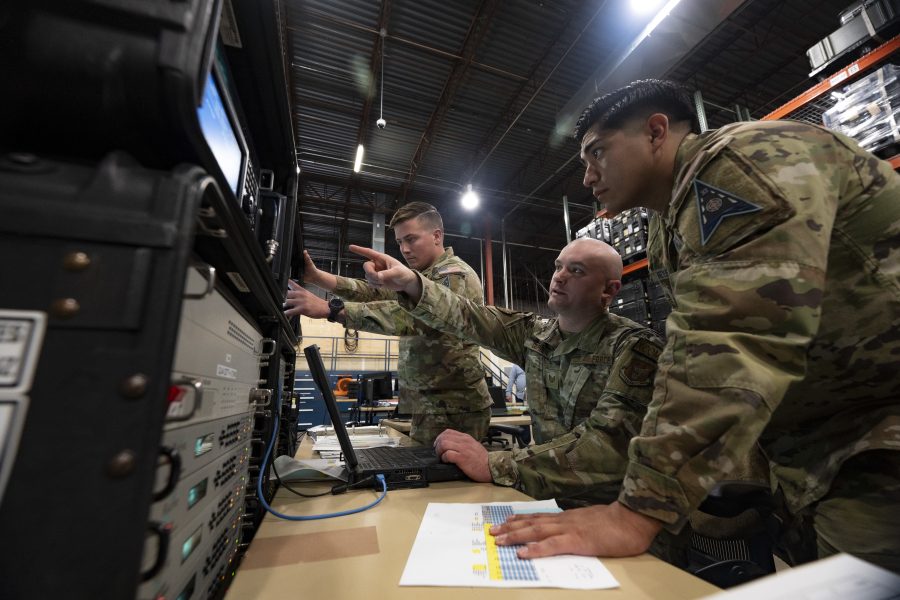NATIONAL HARBOR, Md.—The Space Force used spectrum warfare to ensure B-2 bombers could fly in and out of Iran’s airspace unchallenged during Operation Midnight Hammer in June—and the service is planning to up its game in that area even more in the coming months, top generals said at AFA’s Air, Space & Cyber Conference.
Guardians also provided GPS support to ensure the B-2s’ bunker-busting bombs hit their precise targets within Iranian nuclear facilities.
“It probably goes underreported, but there was a lot that happened from the space warfighting infrastructure in order to facilitate [Midnight Hammer],” Space Operations Command boss Lt. Gen. David N. Miller Jr. said Sept. 24. “So much so that last month, the 509th Operations Group commander [in charge of the B-2 bombers] came out to Peterson to talk to the teams, whether that was the navigation war team that was supporting them, ensuring GPS-enabled weapons can arrive on target, or the electromagnetic warfare team that provided cover fires and the ability to support the ingress and egress of the B-2s.”
Indeed, just as the role of space in defending against Iranian missile barrages last year was initially little-known, the Space Force’s contribution to Midnight Hammer wasn’t widely understood.
Miller, who oversees the service’s combat forces, wants to change that.
“It is the first time we’re able to say there were electromagnetic warfare forces employed in association with that mission … specifically focused on ensuring those B-2s got in and got out at the time and place of our choosing,” Miller said. “The point is, when the U.S. military focuses on something, God help you. And right now, I think the U.S. military is focused on integrating space in a way that we’ve just never seen before.”
Miller didn’t share exact details on what those spectrum warfare troops did, but jamming, spoofing, and other techniques may have helped scramble Iranian defensive systems, letting the stealthy B-2s conduct their mission without fear of being attacked.
For the Guardians of Mission Delta 3, which is responsible for electromagnetic warfare for the Space Force, the operation was one of the most tangible examples of the impact of their work, deputy commander Col. Eddie Gutierrez said during a later panel discussion.
“Really, it’s that warfighter mindset of where they fit into the joint force scheme of maneuver and what they’re able to achieve … from an EW perspective to enable the joint force to execute its fight and put bombs on target,” Gutierrez said.
Chief of Space Operations Gen. B. Chance Saltzman even made a cheeky nod to Midnight Hammer in his Sept. 23 keynote at the conference, noting that Guardians have improved the accuracy of the Global Positioning System such that GPS “can also guide B-2 bombers halfway around the world and steer precision-guided munitions to within inches of their target, in case that’s ever needed.”
Wins for the Spectrum
While the Space Force was able to wield the electromagnetic spectrum to support the operation over Iran, both Saltzman and Miller said the service is looking to up its game even more in that regard.
“Particularly, I’m excited about electromagnetic warfare and where we’re headed there,” Miller said.
USSF’s most public electronic warfare system has been the Counter Communications System. But there’s also Bounty Hunter, a system used to “characterize and geolocate sources of electromagnetic interference or other signals of interest,” according to a service release.
Through recent moves, Miller said “we have literally leaped ahead two weapon system upgrades in the Bounty Hunter electromagnetic surveillance capability.”
There’s also the new Remote Modular Terminal—smaller “portable SATCOM jammers that the joint force will rely on in contested battlefields,” Saltzman said in his keynote.
Development of the terminals was led by the Space Rapid Capabilities Office, but with the first systems transferring to operators, Miller said his command is making big changes to take advantage.
Specifically, because the Space Force is buying more than 150 of the new, smaller systems, “we are in the process of forward positioning some agile systems over the next year or two that are going to allow us to close where we see gaps,” Miller said.
And because the upgraded Bounty Hunter and RMTs can be operated more remotely, Guardians will have further reach with less strain than they do operating the much bulkier CCS, of which the Space Force only has 16.
“We’ll be able to globally command and control at the tactical level—the surveillance, tracking, and targeting of the electromagnetic spectrum, as opposed to the petty packet of just 16 CCSs being spread on rotations,” Miller said. “The deployment model for us is unsustainable.”
To manage that, Miller announced that SpOC is standing up “the first ever space electromagnetic warfare tactical operations center. “
“We are moving to a remote architecture with a global footprint, where we can synchronize the deployment of the systems, but more importantly, synchronize the electromagnetic surveillance, i.e., when an adversary is jamming or disrupting our systems, we understand where that’s at,” Miller said. “We’re able to geolocate that capability in the future on seconds-to-minutes timelines, whereas we had to deploy capability to augment to do it in the past, and we’ll be able to remotely synchronize in a fallback posture across multiple areas of responsibility.”
All told, “I think you’re going to see over the next year, there’s a lot of wins,” Miller said.


